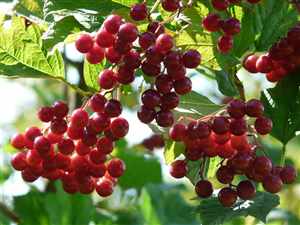Cramp bark (Viburnum opulus)
Main Facts about Cramp bark

Using Cramp bark
Historically, Native Americans used cramp bark as medicine for reducing swollen glands and treating fluid retention, mumps, and eye disorders. They also smoked cramp bark as a substitute for tobacco. These days, as the name suggests, cramp bark is used for relieving cramps, including muscle spasms, menstrual cramps, and cramps during pregnancy. Cramp bark is also used as a kidney stimulant for urinary conditions that involve pain or spasms. Used to help prevent miscarriage, internal bleeding and heart palpitations.Cramp bark is a remedy for: Cold and flu, Anxiety
Caution!
Might constipate a bit, good to take with mild laxative herb or plant. The fruit is edible in small quantities, with a very acidic taste. It is however very mildly toxic, and may cause vomiting or diarrhea if eaten in large amounts. Don’t take tea for more than 3 days at a time.Cooking with Cramp bark
The fruit is edible in small quantities, with a very acidic taste; it can be used to make jelly. It is however very mildly toxic, and may cause vomiting or diarrhea if eaten in large amoHow to grow Cramp bark
Cramp bark is grown as an ornamental plant for its flowers and berries, growing best on moist, moderately alkaline soils, though tolerating most soil types well.| Comfrey |
Cranberry
|